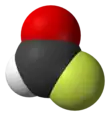Formyl fluoride
Formyl fluoride is the organic compound with the formula HC(O)F.
| |||
| Names | |||
|---|---|---|---|
| Preferred IUPAC name
Formyl fluoride | |||
| Other names
Formic acid fluoride Methanoyl fluoride | |||
| Identifiers | |||
3D model (JSmol) |
|||
| ChemSpider | |||
PubChem CID |
|||
| UNII | |||
CompTox Dashboard (EPA) |
|||
| |||
| |||
| Properties | |||
| CHFO | |||
| Molar mass | 48.016 g·mol−1 | ||
| Appearance | Colorless gas | ||
| Melting point | −142 °C (−224 °F; 131 K) | ||
| Boiling point | −29 °C (−20 °F; 244 K) | ||
| Decomposes | |||
| Solubility in other solvents | Chlorocarbons, Freons | ||
| Structure | |||
| 2.02 D[1] | |||
| Hazards | |||
| Occupational safety and health (OHS/OSH): | |||
Main hazards |
toxic | ||
| Related compounds | |||
Related compounds |
Formic acid Hydrogen fluoride Carbonyl fluoride | ||
Except where otherwise noted, data are given for materials in their standard state (at 25 °C [77 °F], 100 kPa).
Infobox references | |||
Preparation
HC(O)F was first reported in 1934.[2] Among the many preparations, a typical one involves the reaction of sodium formate with benzoyl fluoride (generated in situ from KHF2 and benzoyl chloride):[3]
- HCOONa + C6H5C(O)F → FC(O)H + C6H5COONa
Structure
The molecule is planar; C-O and C-F distances are 1.18 and 1.34 A, respectively.[1]
Reactions
HC(O)F decomposes autocatalytically near room temperature to carbon monoxide and hydrogen fluoride:
- HC(O)F → HF + CO
Because of the compound's sensitivity, reactions are conducted at low temperatures and samples are often stored over anhydrous alkali metal fluorides, e.g. potassium fluoride which absorbs HF.
Benzene (and other arenes) react with formyl fluoride in the presence of boron trifluoride to give benzaldehyde. In a related reaction, formyl chloride is implicated in Gattermann-Koch formylation reaction. The reaction of formyl fluoride/BF3 with perdeuteriobenzene (C6D6) exhibits a kinetic isotope effect of 2.68, similar to the isotope effect observed in Friedel-Crafts acetylation of benzene. Formylation of benzene with a mixture of CO and hexafluoroantimonic acid however, exhibits no isotope effect (C6H6 and C6D6 react at the same rate), indicating that this reaction involves a more reactive formylating agent, possibly CHO+.[3]
Formyl fluoride undergoes the reactions expected of an acyl halide: alcohols and carboxylic acids are converted to formate esters and mixed acid anhydrides, respectively.[4]
References
- LeBlanc, O. H. Jr.; Laurie, V. W.; Gwinn, W. D. (1960). "Microwave Spectrum, Structure, and Dipole Moment of Formyl Fluoride". The Journal of Chemical Physics. 33 (2): 598–600. doi:10.1063/1.1731191.
- Nesmejanow, A. N.; Kahn, E. J. (1934). "Über die unmittelbare Synthese von Säure-fluoriden aus Säuren und die Herstellung von Formylfluorid". Chemische Berichte. 67 (3): 370–373. doi:10.1002/cber.19340670303.
- Olah, G. A.; Ohannesian, L.; Arvanaghi, M. (1987). "Formylating Agents". Chemical Reviews. 87 (4): 671–686. doi:10.1021/cr00080a001.
- Olah, G. A.; Prakash, G. K. S.; Wang, Q.; Li, X. (2001). "Formyl Fluoride". In L. Paquette (ed.). Encyclopedia of Reagents for Organic Synthesis. New York: J. Wiley & Sons. doi:10.1002/047084289X.rf027.

